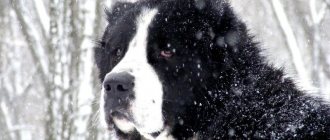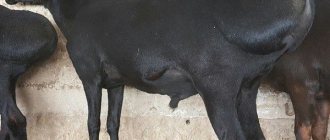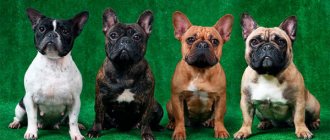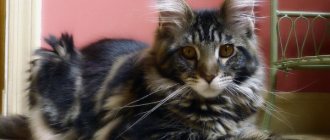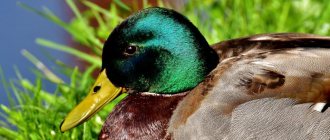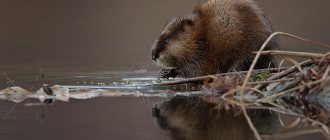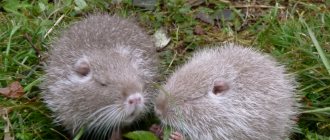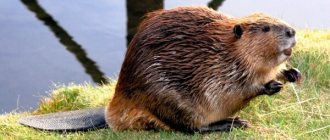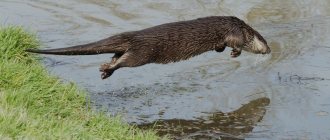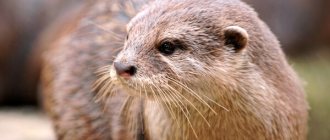The otter, muskrat and nutria are mammals that lead a semi-aquatic lifestyle. It is difficult for an inexperienced person to determine at first glance who is in front of him, how the animals differ, because the animals are similar in many ways. There is a difference between them, and not only external ones. Right now, readers will learn how to distinguish nutria from otters and muskrats.
Nutria
Similarities and differences
If we compare nutria and muskrat, the main difference is their weight and size. The muskrat (musk rat) is much smaller than the nutria (swamp beaver).
The size of a muskrat together with its tail can reach 0.7 m, while at the same time the size of nutria can also reach 0.7 m, but without the length of the tail. The difference in live weight of animals is also significant. Muskrat weighs 0.6-2 kg, nutria about 6 kg, and individuals weighing more than ten kilograms are not uncommon.
Having met these animals in the wild, you can confuse them and this is not surprising, they are very similar. Like nutria, the muskrat has a rounded, somewhat heavy body, covered with thick hair. The neck is short. The shape of the head is blunt, the eyes are small and set high. The ears are small and protrude slightly above the fur. The paws are short with sharp claws. There are membranes between the toes, thanks to which these animals can swim perfectly.
Habitat
The fur of these animals is double, which consists of undercoat and guard hairs. The predominant fur color of the muskrat is red on the back and gray with a blue tint on the belly. The natural color of nutria is somewhat different. Dark brown on the back and lighter on the belly. As a result of selection, it was possible to obtain more than ten completely different colors of nutria fur. From black to silver and pearlescent.
Definitions
Nutria is a mammal, a representative of the order of rodents of the nutria family. It is often also called the swamp beaver due to its external resemblance to this animal. The length of the nutria's body can reach 60 cm, and together with the tail it can reach up to 1 m. The weight of the animal varies from 5 to 12 kg. Nutria has a peculiar physique. Nature has endowed her with a massive body and short legs. On the large head there are miniature eyes and ears. The blunt muzzle is decorated with long thick vibrissae (hard tactile hairs).
Nutria
The animal leads a semi-aquatic lifestyle, which determines some anatomical features of the structure of its organs. For example, the nasal passages of nutria are able to close tightly due to the presence of obturator muscles. The upper lip, divided into two parts, can close behind the incisors, preventing water from entering the oral cavity when eating plants. The animal's hind legs are webbed, and its tail is covered with scaly skin. When moving underwater, it acts as a rudder. The animal's fur is waterproof, consisting of brown undercoat and coarse long hair. An animal can spend about 10 minutes underwater without air.
The muskrat is a rodent mammal belonging to the subfamily of voles. Also called the musk rat. This semi-aquatic animal is native to North America. Subsequently, the animal underwent acclimatization and took root in the territory of Eurasia, including Russia. Muskrats have many external similarities with ordinary gray rats, but their body sizes are much larger. The body length of the animal without a tail can reach up to 36 cm, weight – up to 1.8 kg. The animal has a short neck and a small head with miniature ears that barely protrude from the thick fur. The color of the fur on the back varies from dark brown with red patches to black. The much lighter belly may have a grayish-blue tint.
Muskrat
Muskrats settle mainly along the banks of bodies of water: freshwater swamps, canals, rivers, lakes. The animal remains active throughout the day, but its peak occurs in the evening and morning hours. Moving along the ground rather slowly, the animal is an excellent swimmer. The muskrat is an excellent diver; it can hold its breath for 12-17 minutes. The animal's vision and sense of smell are fairly dull, which forces it to rely mainly on hearing.
What do they eat?
If we talk about nutrition, then it should be noted that in nutrias and muskrats in nature it differs little - it is mainly vegetation, but in otters the diet is mainly dominated by animal food. These animals, unlike many rodents, do not know how to store supplies, which forces them to constantly move in search of something edible.
Powerful otter teeth
Nutria and muskrats have a plant diet of about 95 percent, but sometimes they indulge in such delicacies as mollusks, frogs and crustaceans. As for fish, they are practically indifferent to it.
You should also know that muskrats were brought to Europe from North America, but nutria from South America.
How to catch nutria
When keeping at home, it is very important to know the best and correct way to catch a swamp beaver. Typically, animals kept in cages are not willing to make contact with humans, and any touch on the back is regarded as a direct threat. They cannot be picked up by the withers like rabbits. Correctly catching a swamp beaver means carefully driving it into a corner, but so that the animal does not feel threatened by humans, and carefully lifting it by the tail.
Where live
These animals live in the coastal zone of not only rivers or lakes, but even small ponds and swamps, but only if they do not freeze to the very bottom in the cold season.
Their home breeding is almost identical.
In their habitats, they like to make burrows along the banks and insulate them with various vegetation, ranging from moss to tree foliage.
Now that we have dealt with the main similarities and differences, let’s look at each type of animal separately.
Description
Having understood the main external similarities and differences between mammals, let us consider their description in detail. In the process of getting to know each animal, it will become clear what kind of life they lead, how they reproduce and what they eat.
Otters
These animals are distinguished by a streamlined body with an elongated muzzle and short webbed feet. Characteristics:
Otter appearance
- the body length of the animal is 55-95 cm;
- the tail is not pubescent, scaly, strong, reaching 26-55 cm in length;
- The color on the back is dark brown, on the lower part of the body it is gray-silver.
Otter fur is very thick - there are over 50,000 hairs per square centimeter of skin. Due to this density, water is not able to seep through the underfur. Even when in icy water, the otter does not freeze, since its fur retains heat well.
Lifestyle and nutrition
Otters are solitary animals; they settle on the banks of rivers and lakes where fish are found. Animals prefer shores overgrown with vegetation, cluttered, and washed away. In such places it is easy to find shelter and build a hole.
Attention! The entrance to the otter's burrow is made underwater.
The animals feed on river fish and shellfish, as well as lizards and frogs. Sometimes birds - waders or ducks - serve as food for them. When it becomes difficult to find food in the area where the otter has settled, the mammals wander, covering a distance of 15-20 km per day (over a snow-covered landscape). The animals learned to deftly go down the slope, sliding down on their stomachs.
Reproduction
Otters are able to mate all year round, but in regions where there are severe winters, this happens mainly in the spring.
Attention! Otters mate while in the water.
Pregnancy in these animals can last from 63 to 270 days. The period of whelping directly depends on the conditions in which the female finds herself. The formation and development of fruits occurs within 63 days. However, the mother otter will not give birth to cubs in winter, when food is difficult to obtain. After waiting for the situation to change, she will whelp. There are 3-4 cubs in an otter litter. They are born blind.
Animals become sexually mature late - at 2-2.5 years.
Muskrats
These are small rodents from the subfamily of voles, the genus muskrat. Outwardly, they resemble a gray rat, only twice as large in body size. External characteristics:
Appearance of a muskrat
- oval-shaped body, heavy;
- body length – 23-35 cm (without tail);
- weight – 1.3-1.8 kg;
- the neck is short;
- the head is compact, the muzzle is blunt;
- the ears are barely visible from under the fur;
- the voices are small, located high;
- the lips grow over the incisors (this feature allows the animals to feed underwater);
- the tail is flattened on the sides, scaly, its length is usually equal to the length of the body;
- hind limbs webbed;
- the wool consists of a awn and underfur, it is thick and soft;
- on the back the fur is dark brown, on the belly it is gray-blue.
Lifestyle
Muskrats are herbivorous rodents. Their places of settlement are the banks of reservoirs with rich aquatic vegetation. These animals build burrows, the entrance to which is hidden under water, while the compartments for the cubs are located above the water level. Muskrats also build huts in reed thickets that rise 1.5 meters above the water level. It is noteworthy that the entrance to them is also located under water.
The following types of plants serve as food for the animals:
- reeds;
- sow thistle;
- cane;
- arrowhead;
- cattail
Mollusks, leeches, and small fish are also present in the muskrat menu, but their share in the diet does not exceed 5%.
Attention! Muskrats build pantries to store food for the winter.
Muskrats live in families. Each group has its own feeding area. Males mark their territory using secretions from the gonads. Animals drive members of other families away from their area. Only in winter do they occasionally unite. With the onset of spring, the grown-up offspring leave their “father’s house.” Young males, who do not yet have families, wander in search of free territories.
Muskrats live in families
Reproduction
Muskrats reach sexual maturity at 7-10 months. In warm regions they are able to reproduce all year round, and in cold regions from March to the end of August. Pregnancy in females is short - 30 days, and the litter is large - 6-8 cubs. They are born defenseless and blind, but by the tenth day the babies can swim. At the age of one month, they leave their parents and go in search of their soulmate. If the offspring appeared in autumn or winter, then the young leave their parents in the spring.
Otter
The otter is a small predatory animal that has been able to adapt well to a semi-aquatic lifestyle. Lives in deserted places near water. Otter skin is highly valued due to its high quality not only in our country, but throughout the world. Nowadays, they are successfully bred in captivity, creating conditions close to those to which they are accustomed in the wild.
Otters are found in many parts of our country, although their numbers are small.
Types of otters:
- marine;
- river;
- gigantic;
- ordinary;
- homemade.
At home, they grow and reproduce well, although there are certain difficulties.
Otter family
The main one is home improvement. First of all, it must be spacious; there must be at least 1.5 square meters per individual. A tilting pool is also necessary.
They feed mainly on fish, which they should receive about one kilogram per day. In order to receive numerous offspring from them, considerable experience will be required.
Young animals reach the size of adults by 2 years of age.
If you decide to train and keep a wild animal at home, you may encounter a lot of problems, but if you buy young ones that are not yet four months old, then everything will go much easier. It is known that some specimens survived in captivity for more than 15 years.
Breeding otters as a business is quite a successful direction, but to get a good result you will need to not only learn the habits of this cute animal well, but also make a lot of effort.
Peculiarities of muskrat reproduction
Sexual maturity in adults occurs as early as 8 months after birth. In warm countries and regions, rodent breeding occurs throughout the year. In cold countries, the breeding season begins in the second ten days of March and continues until the end of summer. The duration of gestation by females is one month. At one time, the female gives birth to about 7 cubs. They are born blind and helpless. Already 10 days after birth, muskrat cubs begin to skillfully swim on and under water.
When babies turn one month old, they already become sexually mature, so they go in search of a representative of the opposite sex, with whom they will later start a family and produce offspring.
Important! If a baby is born in winter, he remains with his parents until spring and only when the weather warms does he begin to live independently.
Natural enemies of sea otters
The main enemy of the sea otter in the ocean is the killer whale, and on the shore - the bear and man. The fur of this animal is one of the most valuable; it has no equal in strength and quality. It is for this reason that this species was actively destroyed until the 20th century. Such fishing brought the species to the brink of extinction, and hunting for sea otters was nevertheless banned. But now the species is threatened by new dangers: lack of food, displacement from areas suitable for life, pollution of ocean water. That is why, despite some population growth, the sea otter still remains under protection. In addition, it is quite difficult to breed it in captivity, since the animal is very demanding about the availability of clean water.
Common subspecies of sea otter
Now there are three subspecies of sea otters:
- The common or Asian sea otter (Enhydra lutris lutris) is a resident of the Kuril Islands, Commander Islands and eastern Kamchatka.
- The Californian or southern sea otter (Enhydra lutris nereis) is common on the coast of central California.
- Northern sea otter (Enhydra lutris kenyoni) - found in the Aleutian Islands and southern Alaska.
Hand Taming
Traditionally, there is an opinion that nutria is an animal for meat and valuable fur. This is true. Do not forget that this animal can be a beloved pet and friend.
To tame a nutria, it should be taken into the family as a small animal that no longer sucks its mother’s milk. Nutria very quickly gets used to its nickname and responds to it. With pleasure he takes the offered treat from a person’s hands. She often begs herself, which looks very cute and comical.
These animals are distinguished by their kind and calm disposition. They are very sociable and sociable, do not require special attention. Very neat and clean.
It is safe to say that nutria is a wonderful animal to keep in a house or apartment.
Interesting facts about the sea otter:
- The name sea otter, under which the sea otter is often found, comes from the term “kalakha,” which is translated from the Koryak language as “beast.” The Russian name for this species is considered to be “Kamchatka beaver” or “sea beaver”, despite the fact that the species has nothing to do with river beavers.
- Sea otter fur retains its heat-insulating properties only as long as it is clean, and as it becomes dirty, water begins to penetrate under the hair, hypothermia sets in (the subcutaneous fat layer is quite thin), weakness, and sometimes even the death of the animal. That is why the sea beaver cleans its fur several times a day, and devotes a lot of its time to these procedures.
Sea otter distribution
— Advertising —
The habitat of sea otters is located in the coastal waters of the North Pacific Ocean. This is a narrow arc that begins near the island of Hokkaido (Japan) and goes to the Kuril ridge, the Aleutian and Commander Islands, Kamchatka, Alaska, and California. In Russia, a large group of sea otters lives on Medny Island (Commander Archipelago).
Sea otters usually settle on the coast up to 5 km wide, at depths of up to 20 m, and when calm they go a couple of kilometers deep. Sea otters congregate in areas rich in food, or in shallow waters that are protected from predators.
